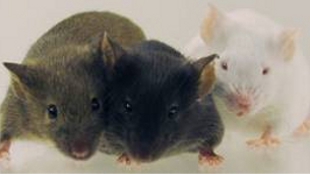A new technique that makes dead mice transparent and hard like plastic is giving researchers an unprecedented view of how different types of cell interact in the body. The approach lets scientists pinpoint specific tissues within an animal while scanning its entire body.
The technique, called vDISCO, has already revealed surprising structural connections between organs, including hints about the extent to which brain injuries affect the immune system and nerves in other parts of the body. That could lead to better treatments for traumatic brain injury or stroke.
Methods that turn entire organs clear have become popular in the past few years, because they allow scientists to study delicate internal structures without disturbing them. But removing organs from an animal’s body for analysis can make it harder to see the full effect of an injury or disease. And if scientists use older methods to make an entire mouse transparent, it can be difficult to ensure that the fluorescent markers used to label cells reach the deepest parts of an organ.
The vDISCO technique overcomes many of these problems. By making the dead mice rigid and see-through, it can preserve their bodies for years, down to the structure of individual cells, says Ali Ertürk, a neuroscientist at Ludwig Maximilian University of Munich in Germany, who led the team that developed vDISCO. He presented the work this month at a meeting of the Society for Neuroscience in San Diego, California.
Crystal clear
The process begins by soaking a mouse’s body in organic solvents to strip it of fats and pigments. This preserves the structure of the mouse’s cells, even as the animal shrinks by up to 60%1.
To explore the transparent mice, Ertürk’s team developed a way to home in on specific cell types, such as neurons or cancer cells. The scientists turned to ‘nanobodies’: antibodies that are found only in llamas, camels and alpacas, and are one-tenth the size of antibody molecules in other species.
Similar to their larger cousins, nanobodies can be engineered to stick to specific proteins that are found only in one type of cell — while carrying fluorescent green markers that labels the chosen cells. And because nanobodies are so small, they can easily pass through tiny blood vessels and into organs.
When the researchers pumped these nanobodies into the circulatory systems of dead mice, which carried the molecules throughout the body, they could see individual cells glowing bright green under a microscope.
The technique is the first to make whole animals truly transparent, says Kwanghun Chung, a medical engineer at the Massachusetts Institute of Technology in Cambridge. “I think it’s a fantastic technology,” he says.
Going deep
So far, experiments with vDISCO have yielded some surprising discoveries, says Ruiyao Cai, a neuroscientist in Ertürk’s lab who also presented data on the technique at the SfN meeting.
One involves mysterious vessels that run between the skull and the brain, which were only discovered in 20152. When Cai’s team used nanobodies to light up lymphatic vessels in a mouse treated with vDISCO, the vessels in the head glowed green — confirming scientists’ suspicions that the structures were part of the system that transports lymph.
Cai and Ertürk also used vDISCO to test how severe injuries to the brain and spinal cord affect cells elsewhere in the body. Labelling neurons showed that nerves in a mouse’s torso degraded after the animal suffered a traumatic brain injury, even though the nerve cells were far from the injury site. In another case, the scientists spotted immune cells that had rushed to the site of a spinal-cord injury days before a mouse died — and, unexpectedly, into surrounding muscle and lymphatic vessels3.
The combination of vDISCO and nanobodies is “kind of the direction for the future,” says Hiroki Ueda, a biologist at the University of Tokyo. The nanobody technique also could be combined with other ways of making an animal’s body transparent, he says, which would expand researchers’ ability to focus in on specific cells and proteins.
Ertürk next plans to use vDISCO to trace how viruses, cancer cells and other invaders spread throughout the body. His group is also designing machine-learning approaches to count and assess labelled cells without introducing bias or human error.







